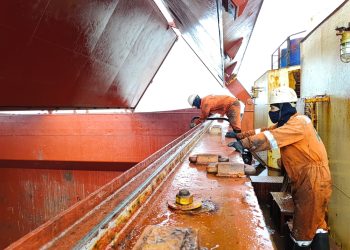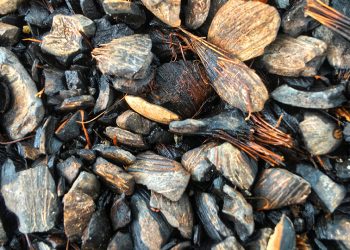Recent changes to IMSBC Code re Iron Ore fines and Iron Ore cargoes

A new iron ore fines (IOF) Schedule to the International Maritime Solid Bulk Cargoes (IMSBC) Code governing the carriage of IOF by sea, and an amended iron ore Schedule, were agreed at the IMO DSC 18 meeting in September 2013, subject to final approval by the IMO Maritime Safety Committee at its 95th session in 2015.
In accordance with the attached recently issued IMO circular DSC.1/Circ.71, which contains these changes to the Code, both Australia and Brazil have now given early effect to the new Schedule. As a result, certain IOF cargoes exported from these two jurisdictions are now reclassified as Group A cargoes under the Code (cargoes which may liquefy if shipped at a moisture content in excess of their Transportable Moisture Limit (TML)), depending on the characteristics of the material.
This circular explains the criteria determining the classification of the cargo for the purposes of the IMSBC Code and the subsequent certification and declaration requirements of the shipper.
Introduction
The new IOF Schedule was presented to the IMO DSC meeting as a joint proposal by the Governments of Brazil and Australia and was supported by an industry group(*1) led by the International Group of P&I Clubs. The Schedule is the product of a wide ranging research project undertaken by Rio Tinto, BHP Billiton and Vale which analysed the behaviour of IOF cargoes carried by sea. The research was independently reviewed by Imperial College, London and Minton, Treharne and Davies (MTD), in order to ensure that the basis for the Schedule was based on sound and impartial scientific research.
The International Group co-ordinated the Imperial College/MTD review of the research work and also led the industry representation on this matter. The Schedule will be mandatory in all SOLAS States Parties from 1 January 2017, but the IMO circular DSC.1/Circ.71 invites States to voluntarily implement the Schedule and a new test procedure as soon as possible.
Background
The changes to the Code categorise certain types of IOF as Group A cargoes and also amend the current IMSBC Code Schedule for iron ore, which is categorised as a Group C cargo (cargoes which are neither liable to liquefy nor to possess chemical hazards). A new IOF test procedure, in the form of a modified Proctor Fagerberg (P/F) test, for determining the TML of IOF cargoes has also been agreed. This new test applies only to IOF cargoes. The existing tests contained in Appendix 2 of the IMSBC Code remain valid for IOF cargoes as well as for all other cargoes.
Goethite content and particle size
Whether an iron ore cargo falls under the new Schedule for IOF or the amended Schedule for iron ore will be determined by the particle size distribution and goethite content of the material (an iron bearing oxide mineral). The research concluded that iron ore cargoes with a goethite content of 30% and greater were not liable to liquefy, but that the same could not be said for material with only 25% goethite content. A minimum goethite content of 35% for categorising IOF as a Group C cargo was therefore agreed as a conservative criterion.
In terms of particle size distribution, iron ore cargoes containing both 10% or more of fine particles less than 1 mm and 50% or more particles less than 10 mm are classified as iron ore fines (Group A), unless they have a goethite content of 35% or more by mass, in which case they may be carried in accordance with the existing Schedule for iron ore (Group C), provided that the Master receives from the shipper a declaration of the goethite content of the cargo which has been determined according to internationally or nationally accepted standard procedures.
This will apply to shipments out of Australia and Brazil for the time being. The International Group has liaised closely with the mining interests and the competent authorities in Australia and Brazil, who have confirmed that they have now given early effect to the new Schedule.
Australia
The Australian Maritime Safety Authority (AMSA) has recently issued an Exemption Certificate to give effect to the voluntary implementation as States are invited to do in DSC.1/Circ.71, which can be found on the AMSA website.
As a result, shippers of iron ore and iron ore fines from Australia may use the new IOF Schedule, modified P/F test method and amended iron ore Schedule as though they are already included in the current version of the IMSBC Code. For IOF cargoes, it is expected that certain shippers in Australia will use this exemption. The International Group is aware that one major shipper of IOF from Australia is already using the modified P/F test to determine the TML of their newly categorised Group A IOF cargoes.
Brazil
The Brazilian Maritime Authority issued Circular No. 390/DPC on 23 December 2013 confirming that the new (draft) IOF Schedule, modified P/F test and amended iron ore Schedule would become effective in Brazil on 27 December 2013 as per the terms of the Circular.
The International Group understands that, in the case of Vale, they have now re-categorised their IOF cargoes mined from Carajas, Brazil as Group A cargoes and are using the modified P/F test method accordingly.
Practical Considerations
For cargoes that are classified as Group A under the IMSBC Code, including where early effect has been given to the new IOF Schedule and the modified P/F method, a cargo declaration accompanied by a signed test certificate(s)(*2) should be provided by the shipper to the Master prior to loading evidencing the moisture content (MC) of the cargo at the time of shipment and the transportable moisture limit (TML). The TML is defined in the Code as the maximum MC of the cargo which is considered safe for carriage, and any cargo with a MC in excess of the TML should not be accepted for loading unless the ship is “specially constructed” or “specially fitted” for this purpose. The declaration of MC shall contain, or be accompanied by, a statement by the shipper that the MC is, to the best of his knowledge and belief, the average MC of the cargo at the time the declaration is presented to the Master.
If a cargo of IOF is to be carried as Group C iron ore on the basis that the goethite content is 35% or more by mass, the shipper should provide the Master with a declaration regarding the goethite content of the cargo prior to loading.
At present, it would appear that only Australia and Brazil have given early effect to the new IOF Schedule and IOF test method, although the existing test methods contained in Appendix 2 of the IMSBC Code still remain valid for use in these two jurisdictions as well.
If a Master is presented with a cargo declaration by the shipper based on the new IOF Schedule and IOF test method, then any guidance from the Club should be sought before loading, especially if the competent authority in the country of loading has not yet given effect to the new Schedule and test method in accordance with DSC.1/Circ.71.
If there is any doubt with regard to an IMSBC cargo declaration for IOF from a shipper based on the new Schedule or modified P/F test, or with regard to categorisation based on particle size goethite content or TML determined using the new test method, further guidance should be sought from the Club.
Conclusion
The conclusion of the IMO’s work to develop a new IOF Schedule to the IMSBC Code and a modified P/F test represents a successful outcome to the concerns previously raised by the International Group with regard to the carriage of IOF by sea from certain jurisdictions. The International Group will continue to liaise with competent authorities to determine whether other States will give early effect to the new Schedules in accordance with IMO Circular DSC.1/Circ.71.
Source: Japan P&I Club





























































